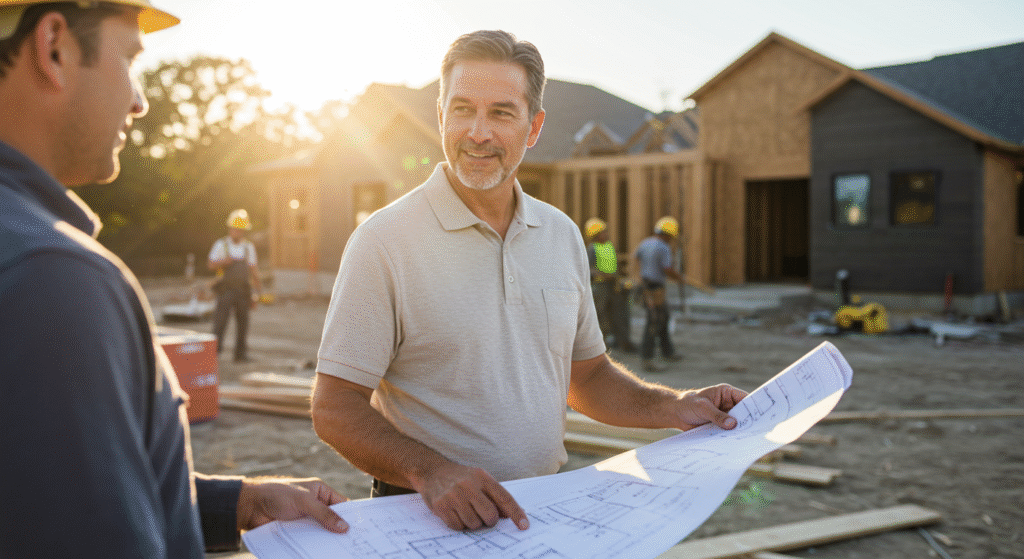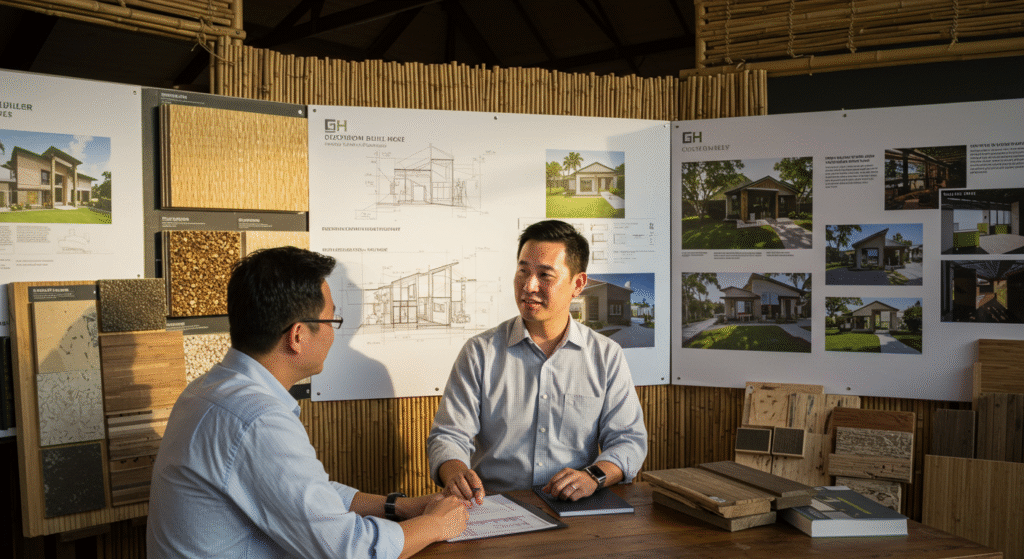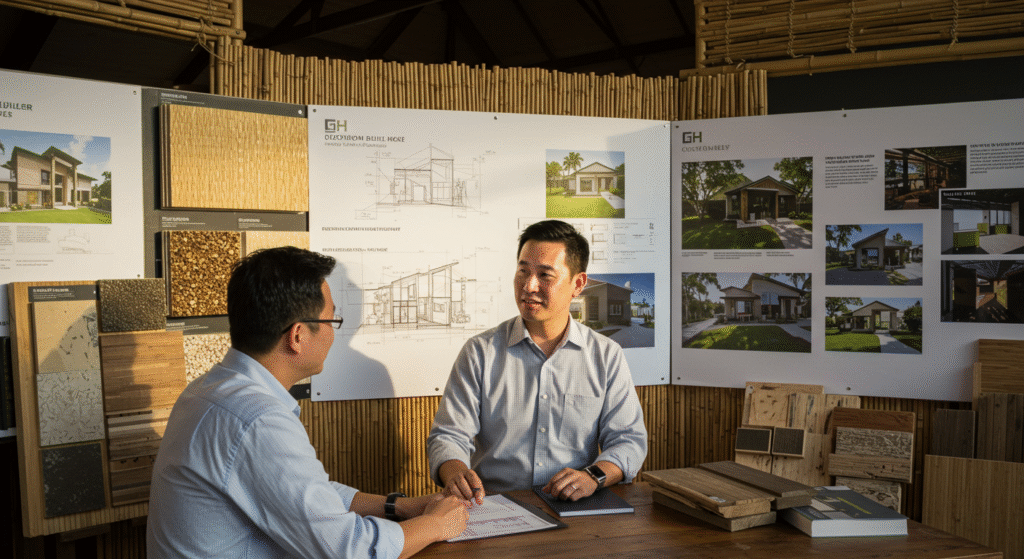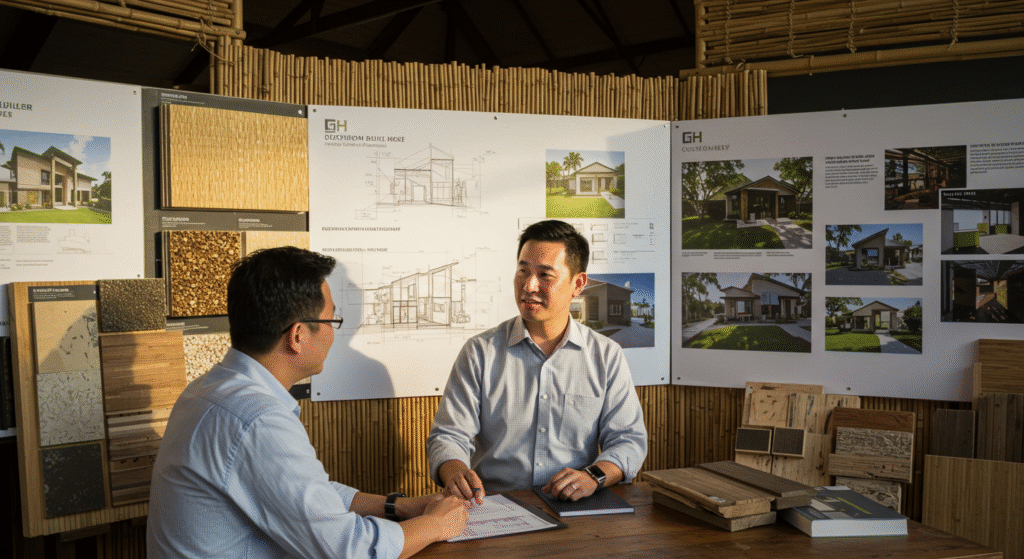Custom Home Builder: A Comprehensive Guide

Custom Home Builder
Table of Contents
- Introduction to Custom Home Builders
- 1.1. What is a Custom Home Builder?
- 1.2. The Role of a Custom Home Builder
- 1.3. Historical Context of Custom Home Building
- The Process of Working with a Custom Home Builder
- 2.1. Initial Consultation and Planning
- 2.2. Design and Architectural Planning
- 2.3. Pre-Construction Planning and Budgeting
- 2.4. Construction and Building Process
- 2.5. Post-Construction and Final Touches
- Benefits of Custom Home Building
- 3.1. Personalization and Tailored Design
- 3.2. High-Quality Materials and Craftsmanship
- 3.3. Energy Efficiency and Sustainability
- 3.4. Increased Property Value
- 3.5. Long-Term Cost Savings
- Challenges and Considerations
- 4.1. Higher Costs and Budgeting
- 4.2. Longer Timelines and Delays
- 4.3. Permitting and Regulatory Issues
- 4.4. Design and Material Selection
- 4.5. Managing Expectations and Communication
- Types of Custom Homes
- 5.1. Modern and Contemporary Designs
- 5.2. Traditional and Classic Designs
- 5.3. Sustainable and Green Homes
- 5.4. Luxury and High-End Homes
- 5.5. Small and Efficient Homes
- The Custom Home Building Process: What to Expect
- 6.1. Land Selection and Site Preparation
- 6.2. Design Development and Blueprints
- 6.3. Permitting and Approvals
- 6.4. Construction Stages: Foundation to Finishing
- 6.5. Final Inspection and Move-In
- Case Studies and Real-World Examples
- 7.1. Modern Dream Home: A Case Study
- 7.2. Traditional Family Home: Lessons Learned
- 7.3. Sustainable Eco-Home: Success Story
- 7.4. Luxury Estate: Challenges and Triumphs
- 7.5. Small but Mighty: Efficient Home Design
- Overcoming Challenges: Strategies and Solutions
- 8.1. Budgeting and Cost Management
- 8.2. Time Management and Scheduling
- 8.3. Effective Communication and Collaboration
- 8.4. Problem-Solving and Adaptability
- 8.5. Quality Control and Assurance
- Best Practices for Custom Home Building
- 9.1. Research and Planning
- 9.2. Clear Communication and Expectations
- 9.3. Quality Materials and Craftsmanship
- 9.4. Sustainability and Energy Efficiency
- 9.5. Regular Inspections and Quality Control
- Emerging Trends in Custom Home Building
- 10.1. Smart Home Technology and Automation
- 10.2. Sustainable and Green Building Practices
- 10.3. Modern and Innovative Design Trends
- 10.4. Energy Efficiency and Net-Zero Homes
- 10.5. Integration of Outdoor and Indoor Spaces
- Conclusion
- 11.1. Summary of Key Points
- 11.2. The Value of Custom Home Building
- 11.3. Encouragement for Future Homeowners
- 11.4. The Future of Custom Home Building
1. Introduction to Custom Home Builders
Custom Home Builder
1.1. What is a Custom Home Builder?
A custom home builder is a professional or company that specializes in constructing homes tailored to the specific needs, preferences, and desires of individual clients. Unlike production builders who create multiple similar homes, custom home builders focus on creating unique, one-of-a-kind residences.
1.2. The Role of a Custom Home Builder
The role of a custom home builder involves managing the entire process of designing and constructing a custom home. This includes working with architects, designers, and contractors to bring the client’s vision to life. The builder is responsible for overseeing the project from start to finish, ensuring that it is completed on time, within budget, and to the client’s satisfaction.
1.3. Historical Context of Custom Home Building
The concept of custom home building dates back to ancient times, where wealthy individuals commissioned architects and builders to create unique and luxurious homes. Over the centuries, the practice has evolved, with advances in technology, materials, and design techniques allowing for greater creativity and personalization.
2. The Process of Working with a Custom Home Builder

2.1. Initial Consultation and Planning
The process begins with an initial consultation between the client and the custom home builder. During this meeting, the client shares their vision, budget, and requirements. The builder assesses the feasibility of the project and provides initial guidance on design, materials, and timelines.
2.2. Design and Architectural Planning
Next, the builder works with architects and designers to create a detailed design and architectural plan. This involves developing blueprints, selecting materials, and ensuring that the design aligns with the client’s preferences and budget.
2.3. Pre-Construction Planning and Budgeting
Pre-construction planning involves finalizing the design, obtaining necessary permits, and establishing a detailed budget. The builder also selects and hires subcontractors, ensuring that all aspects of the project are carefully planned and coordinated.
2.4. Construction and Building Process
The construction phase involves breaking ground and beginning the actual building process. The builder oversees the construction, ensuring that the project progresses according to plan. Regular inspections and updates are provided to the client to keep them informed of the progress.
2.5. Post-Construction and Final Touches
Once the main construction is complete, the builder focuses on the final touches, including interior finishes, landscaping, and any last-minute adjustments. A final inspection is conducted to ensure that the home meets the client’s expectations and all necessary standards.
3. Benefits of Custom Home Building
3.1. Personalization and Tailored Design
One of the primary benefits of custom home building is the ability to create a home that is tailored to the client’s specific needs and preferences. This allows for a high level of personalization, ensuring that the home is a perfect fit for the client’s lifestyle.
3.2. High-Quality Materials and Craftsmanship
Custom home builders often use high-quality materials and employ skilled craftsmen, resulting in a home that is not only beautiful but also durable and long-lasting. The attention to detail and commitment to quality ensure that the home stands the test of time.
3.3. Energy Efficiency and Sustainability
Custom homes can be designed with energy efficiency and sustainability in mind. This can include the use of renewable energy sources, energy-efficient appliances, and eco-friendly building materials, resulting in lower utility bills and a reduced environmental impact.
3.4. Increased Property Value
A custom home is often a valuable investment, as it is tailored to the client’s needs and preferences. The unique design and high-quality construction can increase the property’s value, making it a worthwhile investment for the future.
3.5. Long-Term Cost Savings
While the initial cost of a custom home may be higher than that of a production home, the long-term savings can be significant. Energy efficiency, lower maintenance costs, and the durability of high-quality materials can result in significant savings over the life of the home.
4. Challenges and Considerations

4.1. Higher Costs and Budgeting
Custom home building is often more expensive than purchasing a production home. The cost of land, materials, and labor can add up quickly, requiring careful budgeting and financial planning.
4.2. Longer Timelines and Delays
The process of building a custom home is typically longer than that of a production home. This can be frustrating for clients who are eager to move into their new home. Delays can occur due to weather, material shortages, or unexpected issues during construction.
4.3. Permitting and Regulatory Issues
Obtaining the necessary permits and complying with local building codes and regulations can be a time-consuming and sometimes frustrating process. Delays in permitting can push back the start of construction and extend the overall timeline.
4.4. Design and Material Selection
Selecting the right design and materials can be overwhelming for clients. With so many options available, it can be difficult to make decisions that align with the client’s vision and budget.
4.5. Managing Expectations and Communication
Clear communication between the client and the builder is crucial to the success of the project. Misunderstandings and unrealistic expectations can lead to conflicts and dissatisfaction.
5. Types of Custom Homes

5.1. Modern and Contemporary Designs
Modern and contemporary designs are popular choices for custom homes. These homes feature clean lines, minimal ornamentation, and an emphasis on functionality and efficiency. They often incorporate large windows, open floor plans, and the latest smart home technologies.
5.2. Traditional and Classic Designs
Traditional and classic designs are timeless choices that evoke a sense of warmth and comfort. These homes often feature intricate details, classic architectural elements, and a focus on craftsmanship and quality.
5.3. Sustainable and Green Homes
Sustainable and green homes are designed with the environment in mind. These homes use eco-friendly materials, energy-efficient systems, and innovative design techniques to minimize their environmental impact. They are not only good for the planet but also offer long-term cost savings for the homeowner.
5.4. Luxury and High-End Homes
Luxury and high-end homes are designed for clients who desire the very best in terms of quality, design, and amenities. These homes often feature opulent finishes, advanced smart home technology, and unique design elements that set them apart from other homes.
5.5. Small and Efficient Homes
Small and efficient homes are perfect for clients who value simplicity and sustainability. These homes are designed to maximize space and minimize waste, offering a cozy and comfortable living environment without sacrificing style or functionality.
6. The Custom Home Building Process: What to Expect

6.1. Land Selection and Site Preparation
The process begins with selecting the perfect piece of land for the home. The builder works with the client to evaluate potential sites, considering factors such as location, topography, and zoning regulations. Once the land is selected, the site is prepared for construction, which may involve clearing, grading, and installing utilities.
6.2. Design Development and Blueprints
Next, the builder works with the client to develop a detailed design and architectural plan. This involves creating blueprints that outline the home’s layout, features, and design elements. The plan is refined until it meets the client’s vision and budget.
6.3. Permitting and Approvals
Before construction can begin, the builder must obtain the necessary permits and approvals from local authorities. This can be a lengthy process, but it is essential to ensure that the home is built to code and meets all safety and regulatory requirements.
6.4. Construction Stages: Foundation to Finishing
The construction process involves several stages, starting with laying the foundation and ending with the final finishing touches. Each stage is carefully managed by the builder to ensure that the home is built to the highest standards and meets the client’s expectations.
6.5. Final Inspection and Move-In
Once the construction is complete, the builder conducts a final inspection to ensure that the home is ready for occupancy. Any final touches are added, and the keys are handed over to the client. The builder may also provide a warranty and ongoing support to address any issues that may arise after move-in.
7. Case Studies and Real-World Examples

7.1. Modern Dream Home: A Case Study
This case study highlights the construction of a modern dream home that was designed and built by a custom home builder. The home features cutting-edge design elements, energy-efficient systems, and the latest smart home technologies.
7.2. Traditional Family Home: Lessons Learned
This case study examines the construction of a traditional family home, focusing on the challenges and lessons learned during the process. The home was designed to meet the needs of a growing family, with a focus on functionality and comfort.
7.3. Sustainable Eco-Home: Success Story
This case study showcases the construction of a sustainable eco-home that was built using eco-friendly materials and innovative design techniques. The home serves as a model for sustainable living, demonstrating the potential for energy efficiency and environmental responsibility.
7.4. Luxury Estate: Challenges and Triumphs
This case study provides an in-depth look at the construction of a luxury estate, highlighting the challenges and triumphs experienced during the process. The home features opulent finishes, advanced smart home technology, and unique design elements that set it apart from other homes.
7.5. Small but Mighty: Efficient Home Design
This case study focuses on the construction of a small but efficient home that was designed to maximize space and minimize waste. The home serves as a prime example of how to create a comfortable and functional living environment without sacrificing style or quality.
8. Overcoming Challenges: Strategies and Solutions

8.1. Budgeting and Cost Management
Effective budgeting and cost management are essential for the success of any custom home building project. The builder works closely with the client to establish a realistic budget and ensures that costs are managed throughout the construction process.
8.2. Time Management and Scheduling
Time management and scheduling are critical to ensuring that the project is completed on time. The builder works with contractors and subcontractors to create a detailed schedule and monitors progress to avoid delays.
8.3. Effective Communication and Collaboration
Clear communication and collaboration between the builder, client, and other stakeholders are crucial to the success of the project. Regular updates, open dialogue, and a willingness to address concerns help to build trust and ensure that the client’s expectations are met.
8.4. Problem-Solving and Adaptability
Problem-solving and adaptability are essential skills for a custom home builder. The builder must be able to address unexpected issues and make adjustments as needed to keep the project on track.
8.5. Quality Control and Assurance
Quality control and assurance are top priorities for the builder. Regular inspections and a commitment to excellence ensure that the home is built to the highest standards and meets the client’s expectations.
9. Best Practices for Custom Home Building

9.1. Research and Planning
Thorough research and planning are essential for a successful custom home building project. The client should research potential builders, gather ideas, and develop a clear vision for their home. The builder should also conduct thorough planning to ensure that the project is feasible and meets the client’s needs.
9.2. Clear Communication and Expectations
Clear communication and well-defined expectations are crucial for avoiding misunderstandings and ensuring that the project meets the client’s vision. The builder should maintain open lines of communication and provide regular updates throughout the construction process.
9.3. Quality Materials and Craftsmanship
Using high-quality materials and employing skilled craftsmen is essential for ensuring that the home is durable and long-lasting. The builder should work with reputable suppliers and contractors to ensure that the highest standards are met.
9.4. Sustainability and Energy Efficiency
Sustainability and energy efficiency should be considered throughout the design and construction process. The builder should work with the client to incorporate eco-friendly materials, energy-efficient systems, and innovative design techniques to minimize the home’s environmental impact.
9.5. Regular Inspections and Quality Control
Regular inspections and quality control measures are essential for ensuring that the home is built to the highest standards. The builder should conduct regular inspections and address any issues promptly to ensure that the home meets the client’s expectations.
10. Emerging Trends in Custom Home Building
10.1. Smart Home Technology and Automation
Smart home technology and automation are becoming increasingly popular in custom home building. Homeowners can now integrate advanced systems that allow them to control lighting, temperature, security, and other features from a single device.
10.2. Sustainable and Green Building Practices
Sustainable and green building practices are gaining traction as homeowners become more environmentally conscious. Custom home builders are incorporating eco-friendly materials, energy-efficient systems, and innovative design techniques to create homes that are both beautiful and sustainable.
10.3. Modern and Innovative Design Trends
Modern and innovative design trends are pushing the boundaries of what is possible in custom home building. From open-concept living spaces to unique architectural elements, homeowners are embracing bold and creative designs that reflect their individual style.
10.4. Energy Efficiency and Net-Zero Homes
Energy efficiency and net-zero homes are becoming more prevalent as homeowners seek to reduce their environmental impact and lower their energy costs. Custom home builders are designing homes that produce as much energy as they consume, using advanced insulation, solar panels, and other energy-efficient technologies.
10.5. Integration of Outdoor and Indoor Spaces
The integration of outdoor and indoor spaces is a growing trend in custom home building. Homeowners are creating seamless transitions between living areas and outdoor spaces, with features like large windows, sliding glass doors, and outdoor kitchens.
11. Conclusion

11.1. Summary of Key Points
Custom home building offers a unique opportunity for homeowners to create a home that is tailored to their specific needs and preferences. From the initial consultation to the final move-in, the process involves careful planning, collaboration, and attention to detail. The benefits of custom home building include personalization, high-quality materials, energy efficiency, increased property value, and long-term cost savings.
11.2. The Value of Custom Home Building
The value of custom home building lies in its ability to provide homeowners with a home that is truly one-of-a-kind. Whether it’s a modern dream home, a traditional family home, or a sustainable eco-home, custom home building allows homeowners to bring their vision to life and create a space that reflects their lifestyle and priorities.
11.3. Encouragement for Future Homeowners
For those considering building a custom home, the process can seem daunting, but the rewards are well worth the effort. By working with a reputable custom home builder, conducting thorough research, and maintaining open communication, homeowners can create a beautiful and functional home that meets their needs and exceeds their expectations.
11.4. The Future of Custom Home Building
The future of custom home building is bright, with emerging trends like smart home technology, sustainable practices, and innovative design techniques shaping the industry. As homeowners continue to prioritize personalization, quality, and sustainability, custom home builders will play an increasingly important role in creating homes that are not only beautiful but also functional and environmentally responsible.
This comprehensive guide provides an in-depth look at the world of custom home building, offering insights into the process, benefits, challenges, and emerging trends. Whether you’re a potential homeowner or a professional in the field, this guide serves as a valuable resource for understanding the complexities and opportunities of custom home building.
Pingback: The Complete Guide to Home Builders - worldcivilsociety.com
Pingback: Foundation Repair: A Comprehensive Guide
Pingback: The Role of a General Contractor